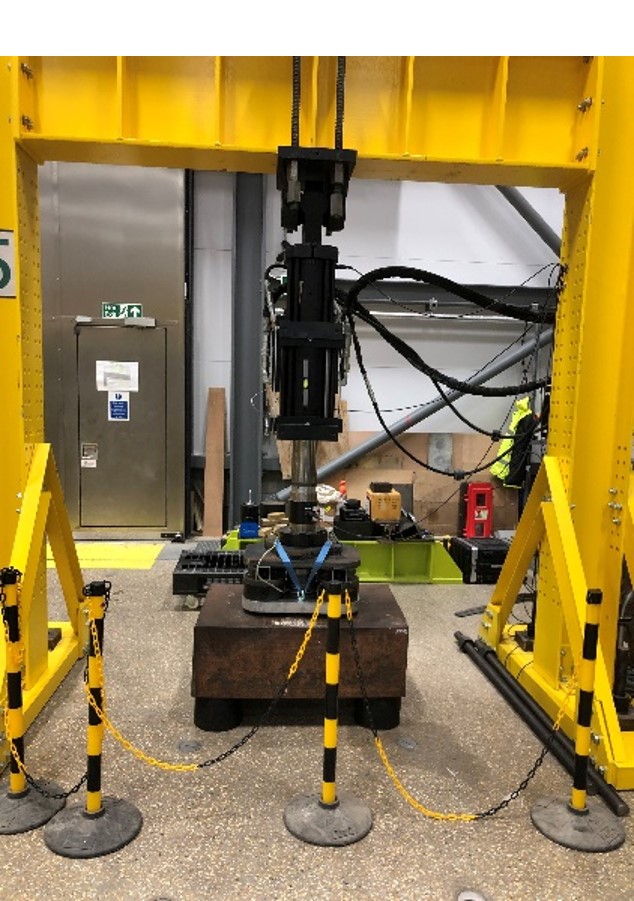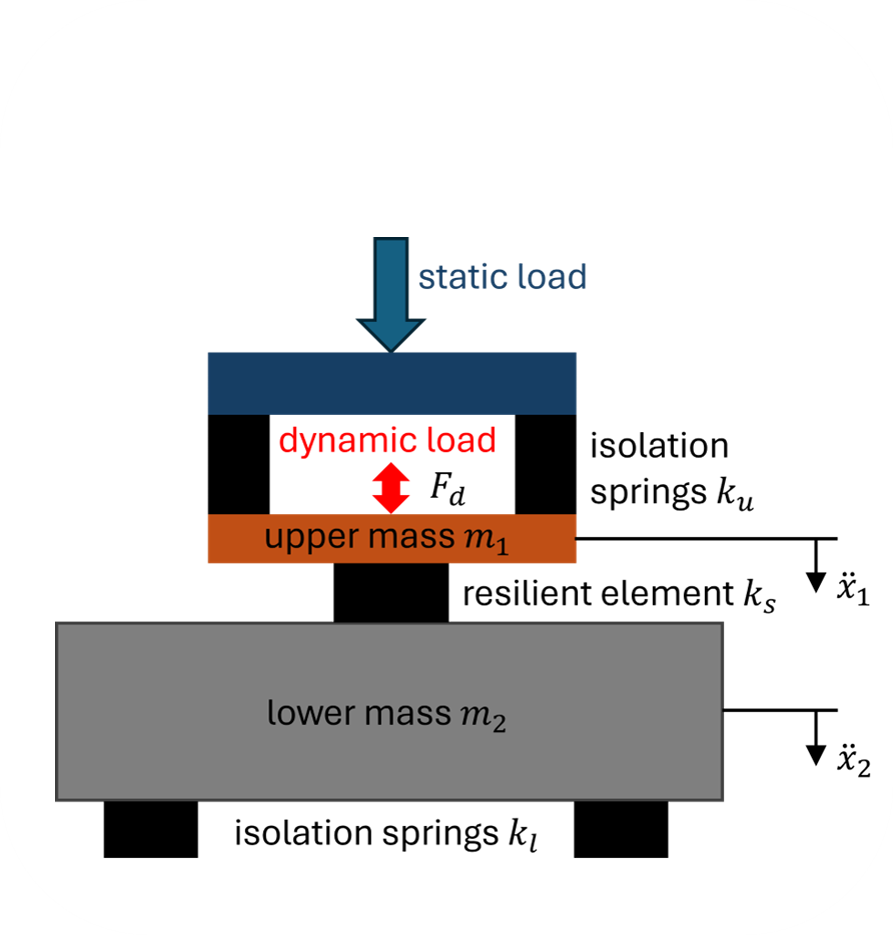Laboratory measurements of dynamic stiffness
Dynamic stiffness is an important metric for predicting and assessing the performance of any resilient element including:
- rail fastener systems and components,
- building and machine isolation bearings,
- engine mounts,
- and more.
At ISVR Consulting, we support clients in performing dynamic stiffness testing over a wide range of frequencies, and can accommodate large static loads on the test samples. Our experienced engineers use cutting-edge equipment and laboratories at the University of Southampton, so you can depend on the accuracy of our results.
Rail fasteners
Rail fastening systems perform an important role in distributing the train load to the sleepers or the slab, as well as in protecting them from excessive dynamic loading. Their types range from simple systems such as rubber rail pads, an elastic layer inserted between the rail and sleeper, held down by fastening clips, to more sophisticated ones that include fastening systems with baseplates and more than one rubber pad. The dynamic properties of the rail fastening system, such as its stiffness and damping, play a key role in the dynamic performance of the track and its vibration and noise emission. The dynamic stiffness affects the degree of coupling between the rail and the foundation as well as the vibration decay rate along the rail.


Rail pads and baseplate intermediate pads are generally manufactured using elastomeric materials (such as natural rubber, EVA, PU, EPDM etc.). Elastomeric materials, can have a higher stiffness at high frequencies than statically, or even than that measured in traditional dynamic tests at a few Hz. Moreover, in the case of dual-stage fastener assemblies the internal resonances due to the vibration of the enclosed steel plate will also affect the dynamic stiffness of the track.
ISVR Consulting have significant experience in vibration testing of specimens with elastomeric behaviour and internal resonances such as the railway track components. For measuring the high-frequency dynamic stiffness, a test rig has been developed in the Large Structures Testing Laboratory (LSTL)* at University of Southampton (Boldrewood Campus). The high-frequency test rig works on the principle of the indirect method, described in ISO 17495:2022 [1] and EN 10846-3:2008 [2]. It can apply static preloads up to 100 kN and dynamically excite the resilient element with an inertial shaker. The dynamic stiffness is determined using the measured vibration of the upper and lower surfaces of the specimen in the frequency range of 20 Hz to 800 Hz.
* The Laboratory accommodates also equipment used from the ISVR Consulting for measuring the static stiffness and low-frequency (<20 Hz) dynamic stiffness of track components.
Test procedure
The ISO 17495:2022 specifies two laboratory test procedures to determine a high-frequency dynamic stiffness, “acoustic stiffness”, of resilient components of rail fastening systems. These are based on two main approaches, known as the direct and the indirect measurement methods. ISVR Consulting was involved in the development of the standard, with our test rig working on the principles of the indirect method [3, 4].
The indirect method involves a test rig with two blocks of known mass; a resilient element can be inserted between them. The lower mass is isolated from the ground. A hydraulic actuator applies the static preload through soft rubber springs (isolators). These isolators filter out the high-frequency vibration/noise from other equipment in the laboratory or hydraulic fluid flow. The hydraulic force is continuously applied in a vertical direction to simulate the weight of the train on the upper block. The upper block is then excited dynamically with an electrodynamic shaker and the responses of the two blocks are measured using accelerometers.


In general, when no internal resonances occur (i.e., standalone pads), a mild dependence of the dynamic stiffness on frequency is measured, whereas the preload leads to a marked increase in the stiffness. The loss factor is relatively unaffected by preload.
For more complex rail fastener systems (i.e., two stage systems), the measured data can be being post-processed and a specific frequency is used to assign a single value for the dynamic stiffness and the damping loss factor from each measurement.
The results from the dynamic stiffness measurements in conjunction with in-situ measurements (i.e., track decay measurements), can also be used in mathematical models for rolling noise and ground borne vibration predictions.
For related information see:
- Estimation of track decay rates and noise based on laboratory measurements on a baseplate fastening system. Hima B.S., Thompson D.J., Squicciarini G., Ntotsios E. and Herron, D. (2021). In, Degrande, G. (ed.) Noise and Vibration Mitigation for Rail Transportation Systems. (Notes on Numerical Fluid Mechanics and Multidisciplinary Design, 150) Springer Cham, pp. 621-628. (doi:10.1007/978-3-030-70289-2_68).
- The influence of baseplate fastening systems on railway rolling noise. Hima B. (2021). University of Southampton, Doctoral Thesis, 214pp.
More applications
Ballast
The dynamic stiffness of ballast (crushed stone) layers have also been measured using ISVR Consulting test rig. Ballast is an non-linear granular material that is also an important component in the dynamic behaviour of the ballasted railway track. It contributes to the resilience of the track support and, in the audible frequency range, its stiffness and damping have an important influence on the component of rolling noise radiated by the sleepers. See:
- Measurements of the high frequency dynamic stiffness of railway ballast and subgrade. Zhang X., Thompson D., Jeong H., Toward M., Herron D., Jones C., and Vincent N. (2020). Journal of Sound and Vibration, 468(115081).
- Characterising the High-Frequency Dynamic Stiffness of Railway Ballast. Herron D., Jones C.J.C., Thompson D., and Rhodes D., The 16th International Congress on Sound and Vibration, Krakow, Poland, 2009.
Building vibration isolation bearings
ISVR Consulting has also performed testing on building vibration isolation bearings for the determination of their dynamic stiffness according to ISO 10846-3:2008 [2]. Such building vibration isolators are also manufactured using elastomeric materials that can result on having higher stiffness at high frequencies than statically, and also they enclose steel plates with internal resonances that can significantly affect the dynamic stiffness of the bearing. The purpose for measuring the dynamic stiffness of the bearings is to understand its influence on the bearing isolation performance.

Contact us
For more information, and to discuss your dynamic stiffness testing requirements, please contact us.
References
- International Organization for Standardization. ISO 17495:2022 – Railway Applications – Acoustics – Determination of the dynamic stiffness of elastic track components related to noise and vibration: Rail pads and rail fastening assemblies, 2022.
- International Organization for Standardization. ISO 10846-3, Acoustics and vibration-Laboratory measurement of vibro-acoustics transfer properties of resilient elements Part 3: Indirect method for determination of the dynamic stiffness of resilient supports for translatory motion, 2002.
- Thompson D. and Verheij J., The dynamic behaviour of rail fasteners at high frequencies. Applied Acoustics, 1997. 52(1): p. 1-17.
- Thompson, D., Van Vliet W. and Verheij J., Developments of the indirect method for measuring the high frequency dynamic stiffness of resilient elements. Journal of Sound and Vibration, 1998. 213(1): p. 169-188.

